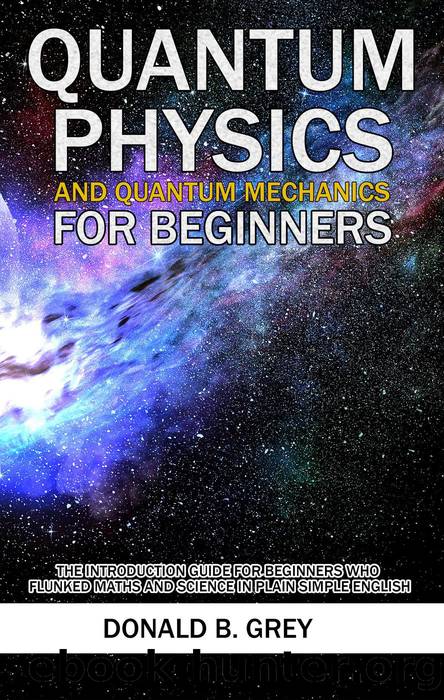Quantum Physics and Quantum Mechanics For Beginners--The Introduction Guide For Beginners Who Flunked Maths and Science In Plain Simple English by Donald B. Grey

Author:Donald B. Grey
Language: eng
Format: epub
Tags: Everyone, best, bestseller, fiction, 2021, 2022, kindle, top, for, adult, teen, everyone, everything, card, gift, For, Poets, Dummies, Everything, Learn, Know, S, Basic, Foundations, World, Idiot, Books, Special, Time, 1, Weird, Overview, God, Bible, Machine, Einstein, Babies, Marco, Mechanics, Theory, Relativity, Magazine, States, Universe, Earth, Atom, Matter, Concepts, Edition, Book, 3, Energy, Healing, Cosmic, Atomic, General, 2, Teach, Dog, Law, Of, Textbook, Young, Adults, Kids, 4
Publisher: Bluesource And Friends
Published: 2020-07-28T16:00:00+00:00
THE UNCERTAINTY PRINCIPLE should not be confused with the similar observer effect, which says that measurements of subatomic particles cannot be taken without disrupting or changing a component of the system. For example, the energy needed to measure the position of an electron or a photon will disrupt the particleâs properties at that moment.
Einsteinâs Argument Against Bohrâs Complementarity
During the Fifth Solvay International Conference in 1927, which concerned electrons and photons, Albert Einstein opposed the existing orthodoxy. This included the well-accepted first law of thermodynamics, known as the law of conservation of energy, plus the law of momentum, to gather information on the state of a particle while undergoing interference. Einstein claimed that his position, based on those two laws, refuted Niels Bohrâs popular principle of complementarity.
Bohrâs complementarity principle appears similar to Heisenbergâs uncertainty: Objects have pairs of properties that are complementary, which prevents the properties from being measured or observed at the same timeâthat is, simultaneously.
But according to Einsteinâs proof of concept, when a monochromatic light beam meets a screen, it is diffracted, and continues on to a second screen with a pair of slits. This results in an interference pattern (F, in the schematic). Assuming only one particle can pass through at a time, and having the ability to detect the impact of the particle on the screen, it is possible to calculate which slit the particle passed through without disrupting the wave quality of the particle.
Download
This site does not store any files on its server. We only index and link to content provided by other sites. Please contact the content providers to delete copyright contents if any and email us, we'll remove relevant links or contents immediately.
The Complete Stick Figure Physics Tutorials by Allen Sarah(6638)
Secrets of Antigravity Propulsion: Tesla, UFOs, and Classified Aerospace Technology by Ph.D. Paul A. Laviolette(3449)
Thing Explainer by Randall Munroe(3327)
The River of Consciousness by Oliver Sacks(2992)
The Order of Time by Carlo Rovelli(2714)
I Live in the Future & Here's How It Works by Nick Bilton(2524)
How To by Randall Munroe(2474)
A Brief History of Time by Stephen Hawking(2473)
The Great Unknown by Marcus du Sautoy(2186)
What If?: Serious Scientific Answers to Absurd Hypothetical Questions by Randall Munroe(2170)
Blockchain: Ultimate Step By Step Guide To Understanding Blockchain Technology, Bitcoin Creation, and the future of Money (Novice to Expert) by Keizer Söze(2137)
Midnight in Chernobyl by Adam Higginbotham(2078)
Networks: An Introduction by Newman Mark(1998)
The Meaning of it All by Richard Feynman(1909)
Easy Electronics by Charles Platt(1864)
The Tao of Physics by Fritjof Capra(1848)
When by Daniel H Pink(1777)
Midnight in Chernobyl: The Untold Story of the World's Greatest Nuclear Disaster by Adam Higginbotham(1775)
Introducing Relativity by Bruce Bassett(1754)
